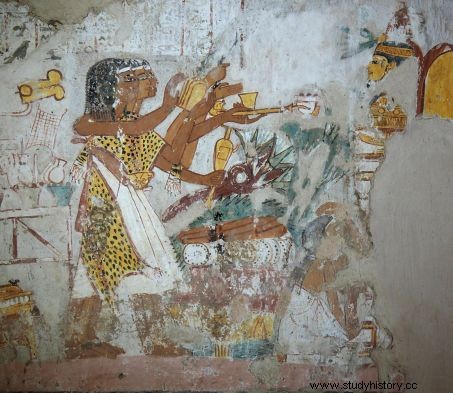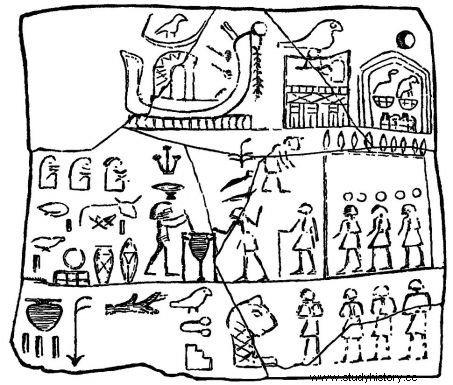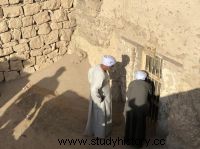For this 15th episode of the Notebooks of Egypt, the interdisciplinary study of the paintings of some tombs of the Valley of the Nobles, in Luxor, leads the team to study a funeral chapel from the end of the 18th dynasty. The hieroglyphic texts were not inscribed on it and the name of its owner is therefore not known.

Scene of preparation of perfumes, tomb TT175
Anonymous, its code name is TT175, for Theban tomb number 175. Reading the scenes suggests that its owner could have been a perfumer. The painting from tomb TT175 shows large basketwork vessels containing the raw materials needed to make perfume. Several men are busy:the first is spraying substances. Three large sealed jars lie on the ground in front of him, probably containing liquids. Another man filters a product through a strainer and collects the resulting liquid. The next three mix the material in large vases while a fourth seems to shape it into the shape of a ball. Further on, the heating of the substances takes place, next to large jars sealed on supports. The perfumer stands above a cauldron placed on a red hearth.

Scene of preparation of perfumes, tomb TT175. ©MAFTO-CNRS/CNRS
It is not about the preparation of a perfume as we understand it today, resulting from the extraction by techniques of enfleurage or distillation of aromatic substances contained in different parts of plants:leaf, fruit, twig, bark, root, sap, moss, wood, seed. The scene rather represents the manufacture of solid aromatic substances used in fumigation, such as incense, and which could contain a large number of ingredients.
A long object, called the "arm of Horus"
Comparison with other documents confirms this hypothesis. Thus, one of the reliefs from the tomb of Petosiris at Tounah el-Gebel shows four men busy heating substances. One stirs the mixture in a basin, while two companions fill two jars. The text states that "perfumers make pleasant-smelling resins ".
Perfumed fumigation accompanied many liturgical gestures performed in the sanctuaries of Egypt under the Pharaohs. The priests then used a long object, called "arm of Horus" which succeeded very early on to the old terracotta cassolettes. This object, often covered in gold leaf, has the shape of an outstretched human arm with a handle that ends in a falcon's head. A cup forms the perfume reserve; the open palm accommodates the incense burner filled with burning embers. The small grains of resinous composition that were thrown into it, burned giving off a smoke containing the aroma of sonter "the substance that makes divine".

Priest holding an arm of Horus to perform a liturgical act of fumigation. Tomb of Nakhtamon, Valley of the Nobles, Luxor © MAFTO-LAMS CNRS

Bronze "Arm of Horus" Censer. Late period. Louvre Museum. Luxor © MAFTO-LAMS CNRS
The oldest representations of heated aromatic substances are found on the jar labels of the first dynasties.
Perfumes had a big role in Egyptian society. Jar labels, dating from the Thinite period (from 3000 to -2700 BC), have been found in Abydos and often refer to sacred oils or perfumes. One of them, discovered in the tomb of Queen Neithhotep in Nagada under the 1 era dynasty, seems to represent a heating scene. Several people emerge from a structure towards a figure who stirs a substance (probably a particular oil mentioned in the lower register) in a large round-bottomed receptacle.

Drawing of the label discovered in the tomb of Queen Neithhotep in Nagada (British Museum), after Garstang , The Tablet of Mena, 1905 © MAFTO-LAMS CNRS
But it is the Greek and Roman authors who have best explained to us the Egyptian practices relating to solid perfumes for fumigation. Plutarch thus wrote that the kyphi of the Egyptians is "a perfume composed of sixteen ingredients, honey, wine, raisins, tiger nut, resin, myrrh, aspalath, seseli, fragrant rush, asphalt, leaves fig tree, sorrel, two kinds of juniper, the big one and the little one, cardamom and aromatic reed.These ingredients are not mixed at random, but in a proportion prescribed by the sacred books, which one reads to measure to those responsible for composing this perfume" (Of Isis and Osiris , translation by D. Ricard, 1844). His statements are confirmed by Galen and Dioscorides, as well as three hieroglyphic texts found in the temples of Edfu and Philae. All specify preparation protocols including grinding, sieving, maceration, mixing, cooking, etc .
As for the sensory properties of kyphi , Plutarch, who had probably experienced it during his long stays in Egypt, explained that "it exhales a soft and active vapor which changes the disposition of the air, insinuates itself into the body , gives his senses a proper movement and invites him agreeably to rest, gives him tranquil affections, and, without causing him any intoxication, releases and relaxes the too vivid impressions which the cares and cares of the day have caused him to experience. , which, like so many links, captivate his faculties . »
These traditions were undoubtedly maintained in the liturgy of the Coptic Church.
The scene of tomb TT175 finds a contemporary continuity in certain practices of the Christians of Egypt. During Holy Week, the Pope of the Coptic Church in person, surrounded by other religious dignitaries, prepares and consecrates the myron , prepared from different flowers and herbs, which after being powdered in a mortar, are cooked with different liquids.
This operation begins on the evening of the sixth Sunday of Lent. Every evening, at the end of each cooking stage, the mixture is left to cool then, at sunrise, it is filtered to separate the aromatics. This oil is then mixed with other substances and the operation is repeated four times. The last boil must be finished before sunrise on Maundy Thursday. The anointing of "myron " will follow the baptism.
A kind of varnish.
Careful observation and chemical analyzes of the paintings make it possible to identify the usual pigments of the Egyptian palette, with red and yellow earths, Egyptian blue and green, carbon black, and vs. but also an organic deposit on the surface of the paint. It was spread over the figures as a homogeneous layer. It is probably a kind of varnish of vegetable origin which was applied in a layer of homogeneous thickness, perhaps to improve the saturation of the colors.

Detail of colors covered with a kind of varnish, now yellow and crystalline in appearance © MAFTO-LAMS CNRS
The images of the notebooks of Egypt
Notebooks of Egypt, 1st episode:how did the painters of ancient Egypt work?
Notebooks from Egypt, 2nd episode:Discovering the funeral chapel of Nakhtamon.
Notebooks from Egypt, 3rd episode:The pigments of Egyptian painting.
Notebooks from Egypt, 4th episode:The modern documentation of painted walls.
Notebooks from Egypt, 5th episode:Rediscovering the monuments of eternity of Ramses II.
Notebooks from Egypt, 6th episode:Revealing pigments with light:the visible and the invisible.
Notebooks from Egypt, 7th episode:Experiencing research through images.
Notebooks of Egypt, 8th episode:Beginning of the study of the paintings of the tomb of Nebamon and Ipouky.
Notebooks from Egypt, 9th episode:A tomb shared by two artists under Amenhotep III.
Notebooks from Egypt, 10th episode:What the tomb of Amenouahsou, an artist from ancient Egypt, reveals.
Notebooks from Egypt, 11th episode:Strange uses that have been made of Egyptian mummies.
Notebooks from Egypt, 12th episode:"Why don't all the artists come here?"
Notebooks of Egypt, 13th episode:Why did the Egyptians draw the characters in profile?
Notebooks from Egypt, 14th episode:Observing craft practices in Egyptian tombs.
Notebooks from Egypt, 15th episode:About Egyptian perfumes.
Notebooks from Egypt, 16th episode:The colors of the Egyptian palette.
Notebooks of Egypt, 17th episode:The Egyptian language does not know a word to designate "art".
Notebooks of Egypt, 18th episode:The day of a scientific mission in Egypt.



